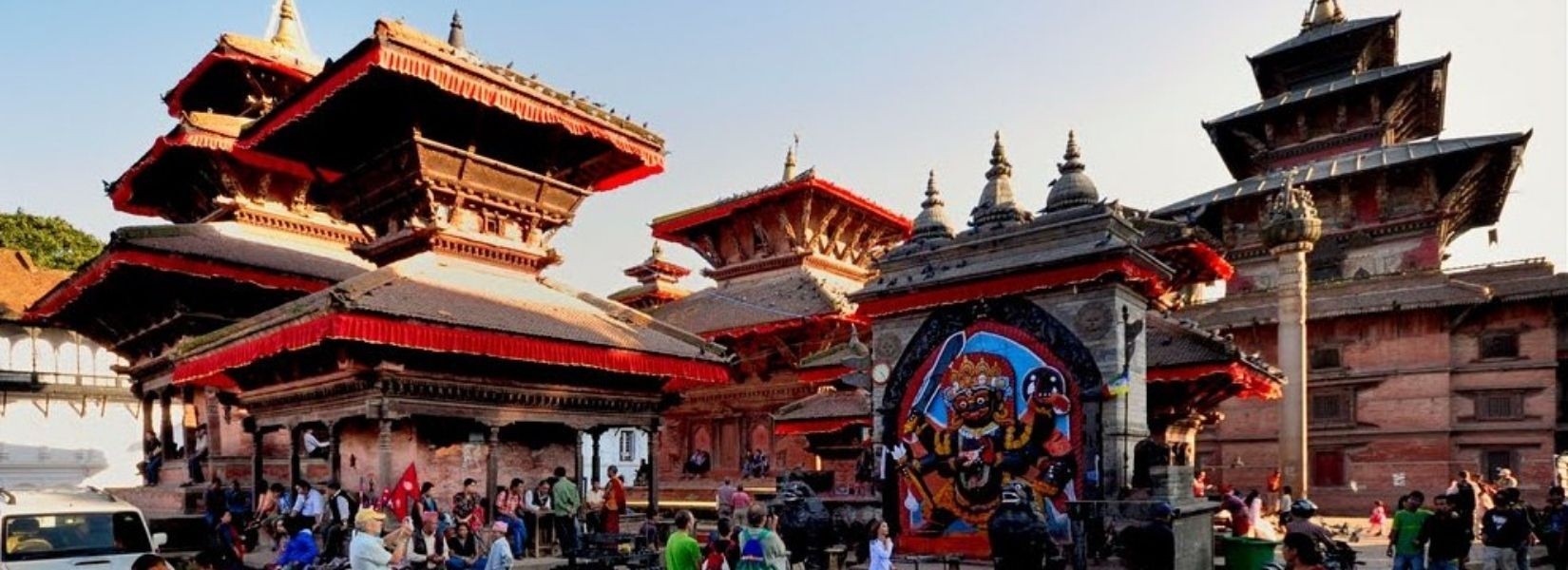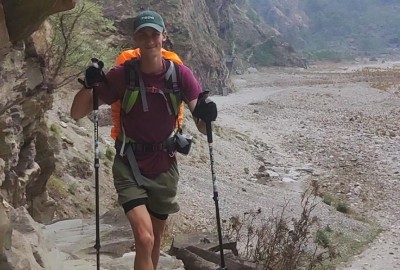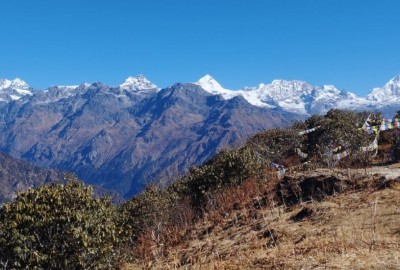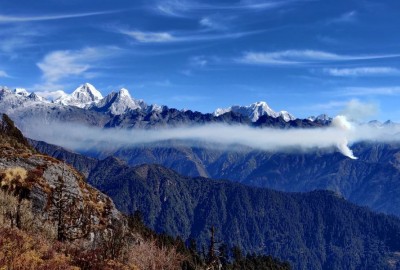Kathmandu Durbar Square is, without doubt, one of the most well known and equally intriguing heritages nestled within the heart of Kathmandu valley. It is also known as Hanuman Dhoka. The word “Hanuman” refers to the Hindu monkey god, of whom a stone statue is placed right next to the main entrance of the ancient Malla palace, as a symbol of protection and strength.
Table of Contents
Plan your trip to Nepal
Customize your trip with help from a local travel specialist.
With the olden royal palace being its centerpiece, Kathmandu Durbar Square is considered to be one of the greatest architectural as well as socio-cultural accomplishments of the Malla Dynasty. With a large array of ancient buildings, temples and monuments adorned with painstakingly made inscriptions and carvings dating all the way from the 15th to the 18th century, each alleyway at the Kathmandu Durbar Square have its own story to tell. It is because of this rich history that it is also one of the three durbar squares enlisted in the UNESCO world heritage sites.
From an architectural perspective, the durbar square is made up of three linked squares; to the South lies Basantapur Square which previously used to house elephant stables but as of now has been adapted into stalls and souvenir shops which lead to Freak Street, an alley often associated with the hippie craze of the ’60s and ’70s. A variety of temples and famous sites are housed in the Western area which is also considered to be the primary square. On the other corner at the North-Eastern side is where the small, yet ornate entrance to the historic Malla royal palace sits.
Aside from gorgeous temples and shrines, the durbar square is filled with other facets of the Newari lifestyle; such as being a venue for numerous festivals, cultural activities, and traditions that the people of the valley have been following for centuries before. Festivities from the likes of Indra Jatra, Gai Jatra, Dashain, Machchhindra-Nath Jatra are some of the more colorful and vivid celebrations you can experience in the brick pavements of Kathmandu Durbar Square. During these times, people from all parts of the city pool around to celebrate the age-old traditions that have been integrated into their way of life. The architecture and designs of the monuments here are phenomenal considering the era that they were built in, which is what makes Hanumandhoka Durbar square one of the most exciting destinations for visitors to Nepal to experience first-hand.
Major Attractions in Kathmandu Durbar Square
With over fifty temples housed at Kathmandu Durbar Square, here’s a list of a few of them which are a must-visit:
Taleju Temple
Built-in 1549 A.D. by King Mahendra Malla, Taleju temple has been crowned as the tallest temple with a height of 35m. It is 12 storeyed square base with 3 floors that has several smaller temples hidden within it that are adorned with carvings of lions and monsters. It has 4 entrances and is constructed such that the Goddess residing within faces the South gate. However, the Taleju temple is one of the most exclusive of the site as it opens to the general public only once a year during the Dashain festival.
Kasthamandap temple
Legend tells us that the whole of Kathmandu city being built around Kasthamandap, a name which literally translates into "Kathmandu". As a matter of fact, the older name for Kathmandu was Kasthamandap but it was eventually adapted to the name we use today. Said to have been built some time in the 12th century, with wood from a single gigantic Assamica Dyer tree, it is the oldest temple located in the durbar square. It is located in the South-West region of the square and was designed to be a 3 story tall temple with a height of 20m. In the years past, Kasthamandap also served as a place to house pilgrims and passersby. There is a log cabin in the middle of the temple which houses the statue of Gorakhnath and has several statues of Lord Ganesh scattered around it. Unfortunately, it was affected by the earthquake of 2015 and is now under reconstruction.
Kumari Bahal
The Kumari Bahal houses Kumari - "The living goddess" of Nepal and is one of the key highlights of Kathmandu Durbar Square. Situated to the left of the Durbar square entrance and East to Kasthamandap, this three-story-high red-bricked building is known for the many intricate wood carvings that have been engraved by hand into it. A Kumari is specifically chosen from the Newar clan of Shakya. Visitors queue around Kumari Bahal to catch a glimpse of the Kumari. The first floor is currently open to tourists but documenting through pictures is strictly prohibited. However, you can buy printed postcards around the area if you want to take home an image of Nepal’s living goddess.
Shiva - Parvati Mandir
Worshipping Lord Shiva and his wife Parvati, the two-storied wooden house is situated in the West end of the durbar square. There are two huge lion statues situated outside the main door guarding the statue of the sacred couple just above them. This temple is perhaps one of the best examples of landscape architecture, sanctioned by the Malla dynasty. Keep in mind Sadhu’s an ascetic’s, who usually come around and ask for a fee in return for a picture.
Kala Bhairab
Said to be the reincarnation of Lord Shiva as the Lord of Terror, Kala Bhairab is situated at the Northside of the durbar square. Holding a sword, an enemy's head and dharma-vessels in six arms, Kala Bhairab is a sinister-looking god whose statue stands at a menacing height of 4-5m. With a good number of devotees praying in front of the statue and putting colorful red and yellow pigment (tika) on it, it is one of the most vibrant spots in the square.
Swet Bhairab
Swet Bhairab is one of the eight bhairab temples situated in the Basantapur Durbar Square. Taken out and opened only one day during Indra Jatra, the statue is otherwise always kept hidden behind a wooden curtain. Regarded as the most dangerous form of Lord Shiva, it was built to protect the city from all threats. When the wooden curtains are drawn back, a pipe fixed within the mouth of Bhairab, distributes traditional Nepali liquor and rice beer to devotees during Indra Jatra.
The Jagannath Temple
Built as a three-tiered platform with two floors, the Jagannath temple is known for its sinfully erotic figures that have been carved onto its roof struts. The temple which Pratap Malla claimed to have constructed during his reign is speculated to have been built in 1563, during the rule of Mahendra Malla. While only the central door opens, there are three doors on each side.
Gaddi Baithak
The Gaddi Baithak is a building from where Nepal's kings ruled and settled the affairs of the country. Gaddi Baithak gets it to name from the fact that it translates to Royal Seat. The kings also welcomed foreign ambassadors and diplomats in this location. The Southern portion of the durbar square is largely dominated by the white Gaddi Baithak building. It was greatly affected by the 2015 earthquake and now is under reconstruction.
The 2015 earthquake has done a lot of damage to a good number of the monuments that existed here. During the time, what once was a placed filled with joy turned into despair, but the community has been slowly building itself up and the reconstruction process has been underway. While the earthquake took a great toll on it, the Kathmandu durbar square is still standing tall, strong and just as beautiful as the day it was made.
Entry Fee
- SAARC Countries: Rs.250 Per Person
- Forgein Countries: Rs.1000 Per Person








